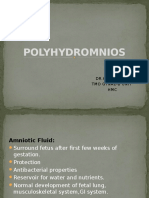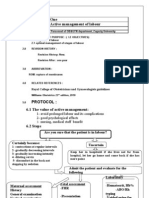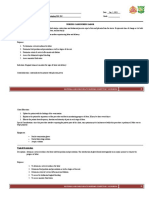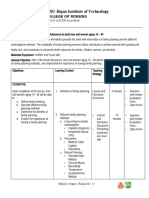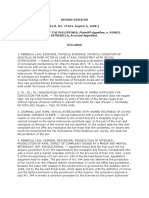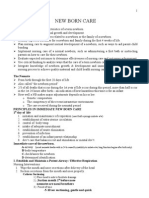100%(1)100% found this document useful (1 vote)
Anatomy and Physiology: Patient P / Room No. 415 - 1
Anatomy and Physiology: Patient P / Room No. 415 - 1
Uploaded by
Julianne B. Dela CruzThe document describes the anatomy and physiology of the female reproductive system. It outlines the internal structures including the ovaries, fallopian tubes, uterus, endometrium, myometrium, and perimetrium. It also describes the external structures such as the vulva, labia, clitoris, urethra, vagina, and cervix. All of these structures work together to produce eggs, support fetal development, experience sexual pleasure, and facilitate childbirth.
Copyright:
© All Rights Reserved
Available Formats
Download as DOCX, PDF, TXT or read online from Scribd
Download as docx, pdf, or txt
Anatomy and Physiology: Patient P / Room No. 415 - 1
Anatomy and Physiology: Patient P / Room No. 415 - 1
Uploaded by
Julianne B. Dela Cruz100%(1)100% found this document useful (1 vote)
The document describes the anatomy and physiology of the female reproductive system. It outlines the internal structures including the ovaries, fallopian tubes, uterus, endometrium, myometrium, and perimetrium. It also describes the external structures such as the vulva, labia, clitoris, urethra, vagina, and cervix. All of these structures work together to produce eggs, support fetal development, experience sexual pleasure, and facilitate childbirth.
Original Description:
female reproductive system
Original Title
Anatomy and Physiology
Copyright
© © All Rights Reserved
Available Formats
DOCX, PDF, TXT or read online from Scribd
Share this document
Did you find this document useful?
Is this content inappropriate?
The document describes the anatomy and physiology of the female reproductive system. It outlines the internal structures including the ovaries, fallopian tubes, uterus, endometrium, myometrium, and perimetrium. It also describes the external structures such as the vulva, labia, clitoris, urethra, vagina, and cervix. All of these structures work together to produce eggs, support fetal development, experience sexual pleasure, and facilitate childbirth.
Copyright:
© All Rights Reserved
Available Formats
Download as DOCX, PDF, TXT or read online from Scribd
Download as docx, pdf, or txt
100%(1)100% found this document useful (1 vote)
Anatomy and Physiology: Patient P / Room No. 415 - 1
Anatomy and Physiology: Patient P / Room No. 415 - 1
Uploaded by
Julianne B. Dela CruzThe document describes the anatomy and physiology of the female reproductive system. It outlines the internal structures including the ovaries, fallopian tubes, uterus, endometrium, myometrium, and perimetrium. It also describes the external structures such as the vulva, labia, clitoris, urethra, vagina, and cervix. All of these structures work together to produce eggs, support fetal development, experience sexual pleasure, and facilitate childbirth.
Copyright:
© All Rights Reserved
Available Formats
Download as DOCX, PDF, TXT or read online from Scribd
Download as docx, pdf, or txt
You are on page 1/ 3
ANATOMY AND PHYSIOLOGY
Patient P / Room No. 415 | 1
Ovary - Produces ova and in mammals secretes the hormones
estrogen and progesterone.
Fallopian Tube – Provide suitable environment for fertilization,
and transport the egg from the ovary to the central channel (lumen)
of the uterus.
Uterus - Hosts the developing fetus, produces vaginal and
uterine secretions, and passes the anatomically male sperm through
to the fallopian tube.
Endometrium - is the innermost lining layer of the uterus, and
functions to prevent adhesions between the opposed walls of the
myometrium, thereby maintaining the patency of the uterine cavity.
Myometrium - is the middle layer of the uterine wall, consisting
mainly of uterine smooth muscle cells (also called uterine myocytes)
but also of supporting stromal and vascular tissue. Its
main function is to induce uterine contractions.
Perimetrium - is the outer serous layer of the uterus. The
serous layer secretes a lubricating fluid that helps to reduce friction.
The perimetrium is also part of the peritoneum that covers some of
the organs of the pelvis.
Urethra - is a hollow tube positioned between the urinary
bladder and urinary meatus which takes urine stored in the bladder
out of the body.
Cervix - It facilitates the passage of sperm into the uterine cavity.
It also maintains sterility of the upper female reproductive tract. The
cervix, and all structures superior to it, are sterile. This ultimately
protects the uterine cavity and the upper genital tract by preventing
bacterial invasion. This environment is maintained by the
INTERNAL frequent shedding of the endometrium, thick cervical mucus and a
narrow external os.
Patient P / Room No. 415 | 2
Vagina - provides a passageway for blood and mucosal tissue Clitoris - an organ that originates from the same cells as the
from the uterus during a woman's monthly period; receives the penis glans penis and has abundant nerves that make it important in
during sexual intercourse and holds the sperm until they pass in to sexual sensation and orgasm.
the uterus; and provides a passageway for childbirth.
Labia Majora - These forms the folds that cover the labia minora,
clitoris, vulva vestibule, vestibular bulbs, Bartholin's glands,
Skene's glands, urethra, and the vaginal opening.
Labia Minora - They function as protective structures that
surround the clitoris, urinary orifice, and vaginal orifice.
Skene’s glands - also called periurethral or paraurethral glands,
are located around the opening of the urethra. The glands may
be involved in sexual stimulation and lubrication for sexual
intercourse.
Vulva - The vulva acts as the gate for the uterus or womb and
provides protection by opening and closing of the lips of the vulva
– labia majora and minora.
Hymen - The hymen is a thin membrane that sometimes partially
covers the entrance to the vagina.
Bartholin’s Glands - are located symmetrically at the posterior
EXTERNAL region of the vaginal opening and play an important role in the
Mons Pubis - The mons pubis is a pad of fat that located at the female reproductive system. These two pea-sized glands are
anterior, over the pubic bone. After puberty, it becomes covered involved in mucus secretion and vaginal lubrication.
in pubic hair. It functions as a source of cushioning during sexual
intercourse, which also contains sebaceous glands that secrete
pheromones to induce sexual attraction.
Prepuce - These skin folds protect the opening of the urethra Source: https://www.google.com/search?
and the vagina.
q=anatomy+of+the+female+reproductive+system
Patient P / Room No. 415 | 3
You might also like
- Essential Intrapartum and Newborn Care (EINC)100% (1)Essential Intrapartum and Newborn Care (EINC)26 pages
- Community Health Nursing Competency Workbook 1: Home VisitNo ratings yetCommunity Health Nursing Competency Workbook 1: Home Visit5 pages
- Community Health Nursing Competency Workbook 1: Clinic Visit100% (1)Community Health Nursing Competency Workbook 1: Clinic Visit6 pages
- Postpartum Haemorrhage (PPH) : DR - Shameem R. AlaasamNo ratings yetPostpartum Haemorrhage (PPH) : DR - Shameem R. Alaasam41 pages
- Post Partal Hemorrhage: Postpartum Complication100% (1)Post Partal Hemorrhage: Postpartum Complication12 pages
- Contracted Pelvis: Kursk State Medical UniversityNo ratings yetContracted Pelvis: Kursk State Medical University24 pages
- Cardiotocograph (CTG) Interpretation and ResponseNo ratings yetCardiotocograph (CTG) Interpretation and Response23 pages
- Physiologic Changes of Pregnancy (Normal) : Local (I.e., Confined To The Systemic (I.e., Affecting TheNo ratings yetPhysiologic Changes of Pregnancy (Normal) : Local (I.e., Confined To The Systemic (I.e., Affecting The9 pages
- Obstetric Injuries To Genital Tract & Obstetric ShockNo ratings yetObstetric Injuries To Genital Tract & Obstetric Shock34 pages
- 001hypertensive Disorders in Pregnancy PDFNo ratings yet001hypertensive Disorders in Pregnancy PDF23 pages
- Birthspacing and Family Planning in Pakistan - Nursing - Tutor's - Final100% (1)Birthspacing and Family Planning in Pakistan - Nursing - Tutor's - Final247 pages
- Orem's Self-Care Theory BY: Josephine NecorNo ratings yetOrem's Self-Care Theory BY: Josephine Necor40 pages
- Ida Jean Orlando: "Nursing Process Theory"No ratings yetIda Jean Orlando: "Nursing Process Theory"10 pages
- Pregnancy and Labor at Fetal Malpresentations and Abnormal Pelvis100% (1)Pregnancy and Labor at Fetal Malpresentations and Abnormal Pelvis40 pages
- Ectopic Pregnancy: Definition: An Ectopic Pregnancy Is One in Which The Fertilized Ovum IsNo ratings yetEctopic Pregnancy: Definition: An Ectopic Pregnancy Is One in Which The Fertilized Ovum Is4 pages
- Hypertensive Disorders of Pregnancy: Priyanka GehlotNo ratings yetHypertensive Disorders of Pregnancy: Priyanka Gehlot50 pages
- Female Reproductive Ogans Internal Organs of ReproductionNo ratings yetFemale Reproductive Ogans Internal Organs of Reproduction22 pages
- Bag Technique: Community Health Nursing Competency Workbook 1No ratings yetBag Technique: Community Health Nursing Competency Workbook 15 pages
- Notions of Development That May Evolve Into ScientismNo ratings yetNotions of Development That May Evolve Into Scientism2 pages
- Historical Antecedents in The Course of Science and Technology100% (1)Historical Antecedents in The Course of Science and Technology1 page
- APGAR Scoring and Ballard's Assessment ToolNo ratings yetAPGAR Scoring and Ballard's Assessment Tool2 pages
- Basketball: Vision: Mission: ObjectivesNo ratings yetBasketball: Vision: Mission: Objectives11 pages
- Cues Objectives Interventions Rationale Evaluation: Nursing Care PlanNo ratings yetCues Objectives Interventions Rationale Evaluation: Nursing Care Plan7 pages
- Physical Examination and Review of Systems: Involuntarily Blinking Pink Conjunctiva100% (1)Physical Examination and Review of Systems: Involuntarily Blinking Pink Conjunctiva3 pages
- Nursing Care Plan: Cues Objectives Interventions Rationale EvaluationNo ratings yetNursing Care Plan: Cues Objectives Interventions Rationale Evaluation10 pages
- Histolytica) Vaginalis) Brucei) Donovani)No ratings yetHistolytica) Vaginalis) Brucei) Donovani)2 pages
- Health Assessment CHECKLISTS 4WITHratingNo ratings yetHealth Assessment CHECKLISTS 4WITHrating13 pages
- Pediatric Vulvovaginal Disorders: A Diagnostic Approach and Review of The LiteratureNo ratings yetPediatric Vulvovaginal Disorders: A Diagnostic Approach and Review of The Literature13 pages
- Anatomy and Physiology of The Male and Female Reproductive System Female Reproductive Anatomy and PhysiologyNo ratings yetAnatomy and Physiology of The Male and Female Reproductive System Female Reproductive Anatomy and Physiology6 pages
- Share: Chanrobles™ Virtual Law Library™No ratings yetShare: Chanrobles™ Virtual Law Library™11 pages
- People vs. Sabardan: G.R. No. 132135. May 21, 2004. PEOPLE OF THE PHILIPPINES, Appellee, vs. DOMINGO SABARDAN, AppellantNo ratings yetPeople vs. Sabardan: G.R. No. 132135. May 21, 2004. PEOPLE OF THE PHILIPPINES, Appellee, vs. DOMINGO SABARDAN, Appellant21 pages
- Part 9 - Human Female Reproductive SystemNo ratings yetPart 9 - Human Female Reproductive System16 pages
- Lifetime Changes in The Vulva and Vagina: ReviewNo ratings yetLifetime Changes in The Vulva and Vagina: Review8 pages
- Procedure 28-18 Assessing The Female Genitals and Inguinal AreaNo ratings yetProcedure 28-18 Assessing The Female Genitals and Inguinal Area2 pages
- Gynaecology Companion For UndergraduateNo ratings yetGynaecology Companion For Undergraduate638 pages
































